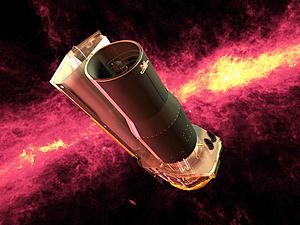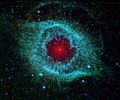Spitzer Space Telescope facts for kids

An artist rendering of the Spitzer Space Telescope.
|
|
| Names | Space Infrared Telescope Facility |
|---|---|
| Mission type | Infrared space telescope |
| Operator | NASA / JPL / Caltech |
| Website | www.spitzer.caltech.edu |
| Mission duration | Planned: 2.5 to 5+ years Primary mission: 5 years, 8 months, 19 days Elapsed: 22 years, 3 months, 26 days |
| Spacecraft properties | |
| Manufacturer | Lockheed Ball Aerospace |
| Launch mass | 950 kg (2,094 lb) |
| Dry mass | 884 kg (1,949 lb) |
| Payload mass | 851.5 kg (1,877 lb) |
| Start of mission | |
| Launch date | 25 August 2003, 05:35:39 UTC |
| Rocket | Delta II 7920H |
| Launch site | Cape Canaveral SLC-17B |
| Entered service | 18 December 2003 |
| End of mission | |
| Disposal | Deactivated in Earth-trailing orbit |
| Deactivated | 30 January 2020 |
| Orbital parameters | |
| Reference system | Heliocentric |
| Regime | Earth-trailing |
| Eccentricity | 0.011 |
| Perihelion | 1.003 AU |
| Aphelion | 1.026 AU |
| Inclination | 1.13° |
| Period | 373.2 days |
| Epoch | 16 March 2017 00:00:00 |
| Main telescope | |
| Type | Ritchey–Chrétien |
| Diameter | 0.85 m (2.8 ft) |
| Focal length | 10.2 m (33 ft) |
| Wavelengths | infrared, 3.6–160 μm |

|
|
The Spitzer Space Telescope was a special telescope launched into space by NASA in 2003. It was the fourth telescope in a big project called the Great Observatories program. The first one was the famous Hubble Space Telescope.
While Hubble sees things in visible light, which is what our eyes can see, Spitzer looked at the universe using infrared light. Infrared light is like heat radiation. This allowed Spitzer to see objects that were hidden from other telescopes.
Unlike Hubble, which orbits the Earth, Spitzer orbited the Sun. It followed Earth in its path around the Sun. This unique orbit helped it stay cool, which is important for seeing infrared light.
The Spitzer Space Telescope was named after a famous scientist named Lyman Spitzer. It was supposed to work for 2.5 to 5 years. But it kept working much longer, until 2020! It helped us learn many new things about space.
Contents
Amazing Discoveries by Spitzer
The Spitzer Space Telescope was very good at seeing tiny details in space. It made some amazing discoveries that changed what we know about the universe.
Seeing Planets Beyond Our Solar System
Spitzer was the first telescope that could directly see light from exoplanets. These are planets that orbit stars outside our own Solar System. This was a huge step in finding other worlds.
Finding the Universe's First Stars
Spitzer also helped scientists find some of the very first stars in the universe. These stars are believed to have formed only about 100 million years after the Big Bang. That's like looking back in time to the universe's baby days!

Images for kids
-
An animation of Spitzer Space Telescope trajectory relative to Earth. Spitzer Space Telescope · Earth
-
The Cepheus C & B Regions. – The Spitzer Space Telescope (30 May 2019).
-
The Spitzer's first light image of IC 1396.
-
The Helix Nebula, blue shows infrared light of 3.6 to 4.5 micrometers, green shows infrared light of 5.8 to 8 micrometers, and red shows infrared light of 24 micrometers.
See also
 In Spanish: Telescopio espacial Spitzer para niños
In Spanish: Telescopio espacial Spitzer para niños











